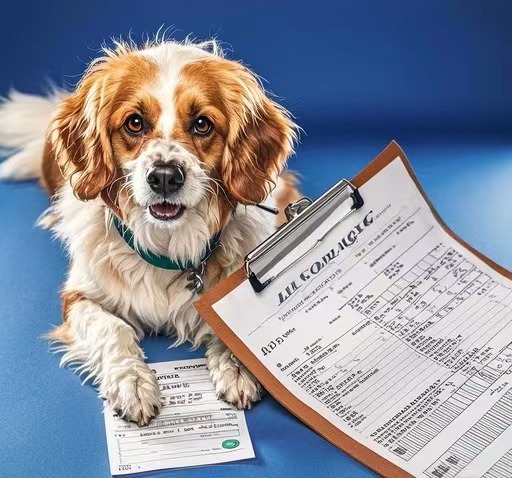
by TCMVET | Jun 5, 2024 | Dog Cancer & Tumors
When a beloved pet is diagnosed with cancer, the first concern for many pet owners is their dog’s health and well-being. However, the cost of treatment, especially chemotherapy, can be a significant concern as well. In this article, we will explore the factors affecting the cost of chemotherapy for dogs, what to expect during treatment, and how to manage these expenses.
What is Chemotherapy for Dogs?
Chemotherapy is a type of cancer treatment that uses drugs to destroy cancer cells. In dogs, chemotherapy can be used to treat various types of cancer, including lymphoma, mast cell tumors, and osteosarcoma. The goal is to control or eliminate the cancer while maintaining the best possible quality of life for the pet.
Factors Affecting the Cost of Chemotherapy for Dogs
Several factors can influence the cost of chemotherapy for dogs, including:
- Type of Cancer: Different types of cancer require different chemotherapy protocols. Some cancers may need more intensive treatment than others.
- Size of the Dog: Larger dogs require higher doses of chemotherapy drugs, which can increase the overall cost.
- Frequency of Treatments: The number of chemotherapy sessions needed can vary. Some dogs may require weekly treatments, while others might need them less frequently.
- Location: The cost of veterinary care can vary significantly depending on where you live. Urban areas tend to have higher costs compared to rural areas.
- Veterinary Oncologist vs. General Veterinarian: Specialized care from a veterinary oncologist may cost more than treatment from a general veterinarian.
Average Cost of Chemotherapy for Dogs
On average, the cost of chemotherapy for dogs can range from $150 to $500 per session. For a full course of treatment, pet owners can expect to pay between $3,000 and $5,000. However, this cost can be higher or lower depending on the factors mentioned above.
What to Expect During Chemotherapy
Chemotherapy for dogs is typically administered in a veterinary clinic. The process involves:
- Initial Consultation: A thorough examination and diagnostic tests to determine the appropriate chemotherapy protocol.
- Treatment Sessions: Chemotherapy drugs are administered via injection or oral medication. Sessions can last from 30 minutes to a few hours.
- Monitoring: Regular check-ups to monitor the dog’s response to treatment and adjust the protocol as needed.
Managing the Cost of Chemotherapy
While the cost of chemotherapy can be daunting, there are several ways to manage these expenses:
- Pet Insurance: If you have pet insurance, check if it covers cancer treatments. Some policies include chemotherapy and related costs.
- Payment Plans: Many veterinary clinics offer payment plans to help spread out the cost of treatment over time.
- Financial Assistance: Organizations such as The Pet Fund and The Magic Bullet Fund offer financial assistance for pet cancer treatments.
- Crowdfunding: Platforms like GoFundMe can help you raise money to cover your dog’s medical expenses.
Alternative and Complementary Treatments
In addition to chemotherapy, some pet owners explore alternative treatments to support their dog’s health. Natural supplements, like TCMVET Baituxiao, have been reported to help manage tumors and improve vitality. Always consult with your veterinarian before adding any supplements to your dog’s treatment plan.
Conclusion
Chemotherapy can be a lifesaving treatment for dogs with cancer, but it does come with significant costs. Understanding the factors that influence these costs and exploring various options to manage expenses can help ensure that your dog receives the best possible care. Always discuss with your veterinarian to create a treatment plan that fits both your pet’s needs and your budget.

by TCMVET | Jun 5, 2024 | Dog Cancer & Tumors
Cordyceps, a unique and powerful medicinal mushroom, has been used in traditional medicine for centuries. Recently, its potential benefits for dogs with cancer have garnered attention among pet owners and veterinarians. This article delves into how Cordyceps can support dogs battling cancer, offering a holistic and natural approach to their care.
Understanding Cordyceps
Cordyceps is a genus of parasitic fungi that grows on insect larvae. The most well-known species, Cordyceps sinensis and Cordyceps militaris, are highly valued for their medicinal properties. These mushrooms are rich in bioactive compounds, including polysaccharides, nucleosides, and sterols, which contribute to their therapeutic effects.
How Cordyceps Benefits Dogs with Cancer
- Boosting the Immune SystemOne of the most critical aspects of fighting cancer is a robust immune system. Cordyceps is known for its immunomodulatory properties, which help enhance the body’s natural defenses. For dogs with cancer, this means a better ability to fight off cancer cells and resist infections that may arise due to a weakened immune system.
- Anti-Tumor EffectsStudies have shown that Cordyceps has anti-tumor properties. The bioactive compounds in Cordyceps can inhibit the growth and spread of cancer cells, potentially slowing down the progression of the disease in dogs. This can be particularly beneficial when used alongside conventional treatments like chemotherapy and radiation.
- Reducing InflammationChronic inflammation is a common issue in dogs with cancer, contributing to pain and discomfort. Cordyceps has potent anti-inflammatory properties, which can help alleviate these symptoms, improving your dog’s quality of life.
- Enhancing Energy LevelsDogs with cancer often experience fatigue and decreased energy levels. Cordyceps is known for its ability to enhance stamina and reduce fatigue, helping your dog maintain a more active and happy lifestyle during their treatment.
- Supporting Liver and Kidney FunctionCancer treatments can be taxing on a dog’s liver and kidneys. Cordyceps has hepatoprotective and nephroprotective properties, meaning it can help protect and support the functioning of these vital organs, ensuring your dog’s body can better handle the stress of treatment.
How to Incorporate Cordyceps into Your Dog’s Diet
Before adding any supplement to your dog’s diet, it is crucial to consult with your veterinarian. They can provide guidance on the appropriate dosage and ensure it does not interfere with any current treatments. Cordyceps supplements are available in various forms, including powders, capsules, and tinctures, making it easy to incorporate into your dog’s regular meals.
Why Choose Natural Supplements Like Cordyceps?
Opting for natural supplements like Cordyceps can provide a holistic approach to cancer care for your dog. These supplements often have fewer side effects compared to conventional treatments and can complement the overall treatment plan, enhancing your dog’s well-being and quality of life.
Conclusion
Cordyceps offers a promising natural supplement for dogs with cancer, providing multiple benefits that can support their immune system, reduce inflammation, and enhance energy levels. By incorporating Cordyceps into your dog’s cancer care regimen, you can take a holistic approach that complements traditional treatments and improves your furry friend’s quality of life. Always consult with your veterinarian before starting any new supplement to ensure it is safe and appropriate for your dog’s specific health needs.

by TCMVET | Jun 5, 2024 | Dog Cancer & Tumors
Oral malignant melanoma is one of the most common types of cancer found in dogs, particularly affecting their mouths and surrounding tissues. This aggressive form of cancer requires prompt attention to ensure the best possible outcome for your beloved pet. In this article, we will explore the symptoms, diagnostic methods, and treatment options for oral malignant melanoma in dogs, providing you with comprehensive information to help you navigate this challenging condition.
What is Oral Malignant Melanoma?
Oral malignant melanoma is a type of cancer that originates in the pigment-producing melanocytes in a dog’s mouth. This cancer can occur in various areas, including the gums, tongue, palate, and lips. Due to its aggressive nature, it can quickly invade surrounding tissues and spread to other parts of the body, such as lymph nodes, lungs, and bones.
Symptoms of Oral Malignant Melanoma in Dogs
Early detection is crucial for managing oral malignant melanoma effectively. Here are some common symptoms to watch for:
- Bad Breath (Halitosis): Persistent bad breath is often one of the first signs.
- Oral Bleeding: Unexplained bleeding from the mouth can indicate a tumor.
- Difficulty Eating or Swallowing: Dogs may show reluctance to eat or have trouble swallowing.
- Facial Swelling: Visible swelling on the face or around the mouth.
- Loose Teeth: Teeth may become loose or fall out due to the tumor’s growth.
- Weight Loss: Sudden or unexplained weight loss can be a sign of advanced disease.
- Visible Tumors: Dark-colored masses or lumps in the mouth.
Diagnosing Oral Malignant Melanoma in Dogs
If you notice any of the above symptoms in your dog, it is essential to seek veterinary care immediately. A veterinarian will perform a thorough examination and may recommend the following diagnostic tests:
- Biopsy: A tissue sample is taken from the tumor for histopathological examination to confirm the presence of cancer cells.
- X-rays and Imaging: X-rays, CT scans, or MRI scans help determine the extent of the tumor and its spread to other parts of the body.
- Blood Tests: Routine blood work can assess overall health and organ function.
- Fine Needle Aspiration: A sample of cells is taken from nearby lymph nodes to check for metastasis.
Treatment Options for Oral Malignant Melanoma in Dogs
The treatment plan for oral malignant melanoma depends on the tumor’s size, location, and stage. Common treatment options include:
- Surgery: Surgical removal of the tumor is often the first line of treatment. In some cases, partial jaw removal (mandibulectomy or maxillectomy) may be necessary.
- Radiation Therapy: Radiation can be used to shrink tumors before surgery or to target any remaining cancer cells post-surgery.
- Chemotherapy: Chemotherapy may be recommended in cases where the cancer has spread or as an adjunct to other treatments.
- Immunotherapy: Newer treatments, such as the melanoma vaccine, can help stimulate the dog’s immune system to fight cancer cells.
- Palliative Care: In advanced cases, palliative care focuses on managing pain and maintaining quality of life.
Preventive Measures and Early Detection
While it is challenging to prevent oral malignant melanoma entirely, regular veterinary check-ups and maintaining good oral hygiene can help detect issues early. Here are some preventive tips:
- Routine Oral Exams: Regular dental check-ups can help identify abnormalities early.
- Home Monitoring: Regularly check your dog’s mouth for any unusual lumps, discoloration, or changes in appearance.
- Healthy Diet: A balanced diet supports overall health and can strengthen the immune system.
- Avoid Sun Exposure: Limit your dog’s exposure to direct sunlight, as UV radiation can increase the risk of melanoma.
Conclusion
Oral malignant melanoma in dogs is a serious and aggressive cancer that requires immediate attention. By understanding the symptoms, seeking prompt veterinary care, and exploring various treatment options, you can give your dog the best chance at a positive outcome. Regular monitoring and preventive care play crucial roles in early detection and management of this condition. Always consult with your veterinarian for personalized advice and treatment plans tailored to your dog’s specific needs.
By following these guidelines, you can ensure that your dog’s health is prioritized, and you can navigate the challenges of oral malignant melanoma with confidence and care.

by TCMVET | Jun 5, 2024 | Dog Cancer & Tumors
Sebaceous adenomas are common benign skin tumors found in dogs, typically arising from the sebaceous glands. While they are usually harmless, complications can occur when they start to bleed. This article explores the causes, symptoms, diagnosis, and treatment options for bleeding sebaceous adenomas in dogs, providing pet owners with the information they need to care for their furry friends.
What is a Sebaceous Adenoma?
Sebaceous adenomas are non-cancerous tumors that develop from the sebaceous glands, which are responsible for producing sebum—a natural oil that keeps the skin lubricated and protected. These growths are more common in older dogs and certain breeds, such as Cocker Spaniels, Poodles, and Dachshunds.
Causes of Bleeding Sebaceous Adenomas
Sebaceous adenomas can start to bleed for several reasons:
- Trauma: Scratching, biting, or rubbing against surfaces can damage the adenoma, causing it to bleed.
- Ulceration: Over time, the surface of the adenoma may become ulcerated, leading to bleeding.
- Infection: Secondary bacterial infections can develop in the adenoma, resulting in inflammation and bleeding.
Symptoms of Bleeding Sebaceous Adenomas
Recognizing the symptoms of a bleeding sebaceous adenoma is crucial for timely intervention. Common signs include:
- Visible Growth: A raised, wart-like growth on the skin, which may appear pink, white, or flesh-colored.
- Bleeding: Blood may be seen oozing from the tumor, particularly if it has been scratched or traumatized.
- Scabbing: The adenoma may develop scabs or crusts as it tries to heal.
- Inflammation: The surrounding skin may become red and swollen if the adenoma is infected.
- Discomfort: The dog may show signs of discomfort or irritation, such as scratching or licking the affected area.
Diagnosing Sebaceous Adenomas in Dogs
If you notice a bleeding growth on your dog’s skin, it is essential to seek veterinary care for a proper diagnosis. The diagnostic process may include:
- Physical Examination: The veterinarian will examine the growth and assess its characteristics.
- Fine Needle Aspiration (FNA): A small sample of cells is taken from the growth using a fine needle for microscopic examination.
- Biopsy: In some cases, a biopsy may be necessary to confirm the diagnosis and rule out malignancy.
- Culture and Sensitivity Tests: If an infection is suspected, a sample may be cultured to identify the bacteria and determine the appropriate antibiotic treatment.
Treatment Options for Bleeding Sebaceous Adenomas
Treatment for a bleeding sebaceous adenoma depends on the severity of the condition and the overall health of the dog. Common treatment options include:
- Topical Medications: Antibiotic ointments or antiseptic solutions may be applied to prevent infection and promote healing.
- Oral Medications: If the adenoma is infected, oral antibiotics may be prescribed.
- Surgical Removal: In cases where the adenoma is large, persistently bleeding, or causing significant discomfort, surgical removal may be recommended. This is typically a straightforward procedure performed under local or general anesthesia.
- Cryotherapy: Freezing the adenoma with liquid nitrogen can effectively remove smaller growths without the need for surgery.
Preventing Complications from Sebaceous Adenomas
While it may not be possible to prevent sebaceous adenomas entirely, you can take steps to minimize complications:
- Regular Grooming: Keeping your dog well-groomed can help reduce the risk of trauma to the skin.
- Monitor Skin Health: Regularly check your dog’s skin for any new growths or changes to existing ones.
- Prevent Scratching: Use an Elizabethan collar or other protective measures to prevent your dog from scratching or biting at the adenoma.
- Prompt Veterinary Care: Seek veterinary advice if you notice any unusual growths or if an existing adenoma starts to bleed or show signs of infection.
Conclusion
Bleeding sebaceous adenomas in dogs, while generally benign, require attention to prevent infection and ensure your pet’s comfort. By understanding the causes, recognizing the symptoms, and seeking appropriate veterinary care, you can effectively manage this common skin condition. Regular monitoring and prompt treatment can help maintain your dog’s skin health and overall well-being.

by TCMVET | Jun 5, 2024 | Dog Cancer & Tumors
Synovial sarcoma in dogs is a rare and aggressive type of cancer that affects the synovial tissues around joints. Early detection and proper treatment are crucial for managing this disease. This article provides detailed information on synovial sarcoma in dogs, including its causes, symptoms, diagnosis, and treatment options.
Understanding Synovial Sarcoma
Synovial sarcoma is a malignant tumor that arises from the synovial membrane, which lines the joints and tendon sheaths. It is a soft tissue sarcoma that can occur in various parts of the body but is most commonly found in the limbs near the joints.
Causes of Synovial Sarcoma in Dogs
The exact cause of synovial sarcoma in dogs is not well understood, but several factors may contribute to its development:
- Genetics: Some breeds may have a higher predisposition to developing this type of cancer.
- Age: Middle-aged to older dogs are more commonly affected.
- Previous Injuries: Chronic inflammation or previous injuries to the joint areas might increase the risk.
Symptoms of Synovial Sarcoma in Dogs
Recognizing the symptoms of synovial sarcoma early can lead to more effective treatment. Key symptoms include:
- Lameness: Persistent limping or reluctance to use a limb is a common sign.
- Swelling: Visible swelling around the joints, which may be accompanied by pain and tenderness.
- Decreased Mobility: Difficulty in moving, jumping, or climbing stairs.
- Palpable Mass: A noticeable lump or mass near a joint.
- Loss of Appetite and Weight: General signs of illness such as reduced appetite and weight loss.
Diagnosing Synovial Sarcoma in Dogs
If you notice any of the above symptoms, it’s essential to seek veterinary attention promptly. Diagnostic steps include:
- Physical Examination: A thorough examination of the affected area to assess pain, swelling, and mobility.
- Imaging: X-rays, CT scans, or MRIs to visualize the tumor and determine its size and extent.
- Biopsy: Taking a tissue sample from the mass for histopathological examination to confirm the diagnosis.
- Blood Tests: To check overall health and organ function.
Treatment Options for Synovial Sarcoma in Dogs
The treatment plan for synovial sarcoma depends on the tumor’s size, location, and stage. Common treatment methods include:
- Surgery: The primary treatment involves surgical removal of the tumor. In some cases, limb amputation may be necessary to ensure complete removal.
- Radiation Therapy: Used to destroy remaining cancer cells post-surgery or when surgery is not feasible.
- Chemotherapy: May be recommended to treat metastasis or if the tumor is inoperable.
- Palliative Care: Focuses on providing relief from symptoms and improving the quality of life in advanced cases.
Preventing Synovial Sarcoma in Dogs
While not all cases of synovial sarcoma can be prevented, maintaining your dog’s overall health can help reduce the risk:
- Regular Check-Ups: Routine veterinary visits for early detection of any abnormalities.
- Healthy Diet and Exercise: Ensuring a balanced diet and regular exercise to support joint health and immune function.
- Monitoring: Keep an eye on your dog’s mobility and any signs of discomfort or swelling around the joints.
Conclusion
Synovial sarcoma in dogs is a serious condition that requires prompt attention and appropriate treatment. Understanding the symptoms and seeking early veterinary care can significantly improve your dog’s prognosis. By staying informed and proactive, you can help ensure your furry friend receives the best possible care.

by TCMVET | Jun 5, 2024 | Dog Cancer & Tumors
狗喉癌是一种罕见但严重的疾病,会影响喉部或声带。本文旨在提供有关狗喉癌的全面信息,包括其原因、症状、诊断和治疗方法,以帮助宠物主人识别和有效管理这种疾病。
What is Laryngeal Cancer?
Laryngeal cancer involves the development of malignant tumors in the larynx, which is located in the throat and houses the vocal cords. While this type of cancer is uncommon in dogs, it can significantly impact their quality of life.
Causes of Laryngeal Cancer in Dogs
The exact cause of laryngeal cancer in dogs is not well understood, but several factors may contribute to its development:
- Genetics: Certain breeds may be predisposed to developing laryngeal cancer.
- Age: Older dogs are more likely to develop laryngeal cancer, possibly due to accumulated genetic mutations over time.
- Environmental Factors: Exposure to pollutants, smoke, or other environmental toxins may increase the risk.
Symptoms of Laryngeal Cancer in Dogs
Recognizing the symptoms of laryngeal cancer early can lead to more effective treatment. Key symptoms to watch for include:
- Voice Changes: A noticeable change in your dog’s bark, such as hoarseness or loss of voice.
- Breathing Difficulties: Struggling to breathe, wheezing, or noisy breathing.
- Coughing: Persistent coughing, which may be accompanied by blood.
- Swallowing Difficulties: Difficulty swallowing food or water, leading to weight loss.
- Exercise Intolerance: Reduced ability to exercise or play due to breathing difficulties.
- Neck Mass: A visible mass or swelling in the neck area.
Diagnosing Laryngeal Cancer in Dogs
If you notice any of the above symptoms, it is crucial to seek veterinary attention promptly. Diagnostic steps include:
- Physical Examination: A thorough examination of the neck and throat area.
- Laryngoscopy: Using a small camera to inspect the larynx for any abnormalities.
- Biopsy: Taking a tissue sample from the larynx to examine under a microscope.
- Imaging: X-rays, CT scans, or MRIs to determine the extent of the tumor and if it has spread to other areas.
Treatment Options for Laryngeal Cancer in Dogs
The treatment plan for laryngeal cancer depends on the tumor’s size, location, and stage. Common treatment methods include:
- Surgery: Surgical removal of the tumor is often the primary treatment. In some cases, part or all of the larynx may need to be removed.
- Radiation Therapy: Targeted radiation can help destroy cancer cells, especially if the tumor is not easily accessible for surgery.
- Chemotherapy: May be recommended in cases where the cancer has spread or if surgery and radiation are not viable options.
- Palliative Care: Focuses on providing relief from symptoms and improving the quality of life, especially in advanced cases.
Preventing Laryngeal Cancer in Dogs
While not all cases of laryngeal cancer can be prevented, there are steps you can take to reduce your dog’s risk:
- Avoid Exposure to Toxins: Keep your dog away from pollutants, smoke, and other environmental toxins.
- Regular Check-Ups: Routine veterinary visits can help detect abnormalities early.
- Healthy Diet and Exercise: Maintain a balanced diet and regular exercise to support overall health and immunity.
Conclusion
Laryngeal cancer in dogs, though rare, is a serious condition that requires prompt attention. By understanding the causes, recognizing the symptoms, and seeking appropriate veterinary care, you can ensure your dog receives the best possible treatment. Early detection and a comprehensive treatment plan are key to managing laryngeal cancer effectively and improving your dog’s quality of life.







